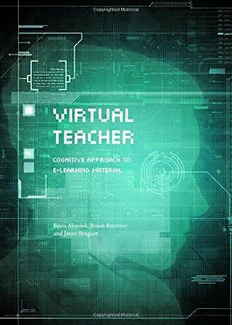
Virtual Teacher: Cognitive Approach to E-learning Material PDF
Preview Virtual Teacher: Cognitive Approach to E-learning Material
Virtual Teacher Virtual Teacher: Cognitive Approach to e-Learning Material By Boris Aberšek, Bojan Borstner and Janez Bregant Virtual Teacher: Cognitive Approach to e-Learning Material, by Boris Aberšek, Bojan Borstner and Janez Bregant This book first published 2014 Cambridge Scholars Publishing 12 Back Chapman Street, Newcastle upon Tyne, NE6 2XX, UK British Library Cataloguing in Publication Data A catalogue record for this book is available from the British Library Copyright © 2014 by Boris Aberšek, Bojan Borstner, Janez Bregant All rights for this book reserved. No part of this book may be reproduced, stored in a retrieval system, or transmitted, in any form or by any means, electronic, mechanical, photocopying, recording or otherwise, without the prior permission of the copyright owner. ISBN (10): 1-4438-6524-9, ISBN (13): 978-1-4438-6524-1 CONTENTS List of Figures.............................................................................................. x Acknowledgements ................................................................................... xii Introduction................................................................................................. 1 Part I: Historical Landmarks Chapter One ................................................................................................. 6 History of Education Ancient Greece and Rome The period of renaissance The age of enlightenment Large contemporary teaching currents Future of education Chapter Two .............................................................................................. 19 History of Mind Influential traditional views Contemporary philosophical positions Schematic overview of basic theories of mind Chapter Three ............................................................................................ 45 History of Artificial Intelligence (AI) Historical overview AI as science today Symbolic computation Intelligent agents What seems possible and what not? Summary ................................................................................................... 57 Mind, Machines and Cognition vi Contents Part II: Information-Processing Models of Mind Chapter Four .............................................................................................. 60 Cognitive Science Birth of cognitive science Cognitive science and reverse engineering Cognitive science and neuromorphic engineering Cognitive science and the integrated approach Cognitive architectures Chapter Five .............................................................................................. 72 Symbol Systems The structure of a neuron and symbol manipulators Strong and weak symbol system hypothesis Seeing minds as computers Computational theory of mind Empirical differences between brains and computers: where do they lead? The only game in town? Chapter Six ................................................................................................ 86 Connectionist Networks Forerunners of connectionism Neurons again Structuring connectionist networks Artificial and biological networks: data processing similarities and differences Symbols or networks? Chapter Seven .......................................................................................... 103 Artificial Forms of Life Networks, robots and cognition No representations in cognitive architectures? Chinese room and Chinese gym No armchair philosophy? Summary ................................................................................................. 112 Symbols vs. Networks: Pros and Cons Virtual Teacher: Cognitive Approach to e-Learning Material vii Part III: Other Approaches to Human Cognition Chapter Eight ........................................................................................... 116 Hybrid Models History of birth Structure of hybrid systems How does ACT-R work? Overview of ACT-R's symbolic and sub-symbolic dimensions of knowledge and learning Chapter Nine ............................................................................................ 125 Dynamical Systems Dynamical systems theory (DST) Structure of dynamical systems Watt’s centrifugal governor as a dynamical system: role model for human cognition Summary ................................................................................................. 135 Optimism or Pessimism? Part IV: Dynamical Modelling and Mind Chapter Ten ............................................................................................. 138 What is System Modelling? Mathematical models and computer simulation Dynamical modelling in neuroscience Hodgkin-Huxley model (HH) Chapter Eleven ........................................................................................ 149 Dynamical Modelling of Cognitive Capacities Dynamics of motoric skills Haken, Kelso and Bunz model (HKB) Evaluating dynamical models of cognition Chances of realizing artificial brain Brain simulating models Blue Brain Project Summary ................................................................................................. 165 Where Are We At? viii Contents Part V: Cognitive Science and Education: New Horizons Chapter Twelve ....................................................................................... 168 Cybernetics, Society and Pedagogy Cybernetics and society Cybernetic pedagogy Mistakes in cybernetic pedagogy Revised cybernetic pedagogy Chapter Thirteen ...................................................................................... 183 Intelligent Tutoring Systems in Education Education and society Intelligent tutoring systems (ITS) or virtual teachers: what are they? Components of ITS E-learning material Chapter Fourteen ..................................................................................... 197 Virtual Teacher based on mRKP: Case Study ITS supported by STATEX expert system (ITS-SES) Elements of ITS-SES Using ITS-SES: optimization of gear assemblies Summary ................................................................................................. 219 mRKP as Hybrid Approach to e-learning Material Part VI: Implications Chapter Fifteen ........................................................................................ 222 Nomological Reduction Motivation: Unity of science Nagel sets course Fall of Nagel reduction Chapter Sixteen ....................................................................................... 231 Functionalist Reduction How does it work? Mental causation: is it in the way? Ready to accept it? Virtual Teacher: Cognitive Approach to e-Learning Material ix Chapter Seventeen ................................................................................... 248 Molecular Reduction Background: Neuroscience steps in Long term memory (LTM) as example of mind-body reduction Multiple realization again Algorithmic Reduction Summary ................................................................................................. 265 Reduction of Mind Conclusion ............................................................................................... 267 References ............................................................................................... 269 Index ........................................................................................................ 285
